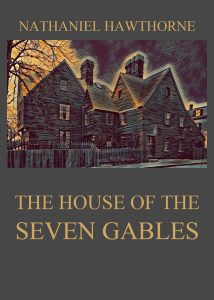The House Of The Seven Gables – Nathanie Hawthorne
This book, which the author himself preferred to his previous novel, is of quieter tone than “The Scarlet Letter.” It is more minutely elaborated, and its pathos depends more on the peculiar temperaments of its characters. The scene is laid in Salem, and the house, which much effort has been made to identify, corresponds in many points to an old dwelling formerly standing there, known as the Curwen House, and sometimes called “the old witch-house.” Some points in the story corresponding to the history of the Hawthornes were noted in the beginning of this sketch. The character of Clifford and the problem of his strange destiny, the mockery of fate, which, having adapted him so delicately to an existence of sensuous refinement, stripped him in his youth, at one brutal stroke, of everything fair in life, and threw him among the lowest and coarsest surroundings, is the great study of the book. Its pervading thought is the theory of inheritance, the repetition of an original type now and then down a family line, and the curse of wrong-doing, blasting innocent lives when wronger and wronged are dust. The characters of Hepzibah and Phoebe are beautiful types, strongly contrasted on the surface, but having at bottom an intimate kinship in moral uprightness and capacity for devotion. That of Judge Pyncheon also is exquisitely worked out in the subtle self-deception of the hypocrite,—no character being so great a favorite in fiction, and none so often badly drawn, as that of the hypocrite, because it looks so much more easy and uncomplicated than it is.
The House Of The Seven Gables.
ISBN: 9783849672270
Available at amazon.com and other venues.
Plot summary of The House of the Seven Gables (from Wikipedia):
The novel is set in the mid-19th century, but flashbacks to the history of the house, which was built in the late 17th century, are set in other periods. The house of the title is a gloomy New England mansion, haunted since its construction by fraudulent dealings, accusations of witchcraft, and sudden death. The current resident, the dignified but desperately poor Hepzibah Pyncheon, opens a shop in a side room to support her brother Clifford, who has completed a thirty-year sentence for murder. She refuses all assistance from her wealthy but unpleasant cousin, Judge Jaffrey Pyncheon. A distant relative, the lively and pretty young Phoebe, arrives and quickly becomes invaluable, charming customers and rousing Clifford from depression. A delicate romance grows between Phoebe and the mysterious attic lodger Holgrave, who is writing a history of the Pyncheon family.
The house was built on ground wrongfully seized from its rightful owner, Matthew Maule, by Colonel Pyncheon, the founder of the Massachusetts branch of the family. Maule was accused of practicing witchcraft and was executed. According to legend, at his death Maule laid a curse upon the Pyncheon family. During the housewarming festivities, Colonel Pyncheon was found dead in his armchair; whether he actually died from the curse or from a congenital disease is unclear. His portrait remains in the house as a symbol of its dark past and the weight of the curse upon the spirit of its inhabitants.
Phoebe arranges to visit her country home, but plans to return soon. Clifford, depressed by his isolation from humanity and his lost youth spent in prison, stands at a large arched window above the stairs and has a sudden urge to jump. The departure of Phoebe, the focus of his attention, leaves him bed-ridden.
Judge Pyncheon arrives to find information about land in Maine, rumored to belong to the family. He threatens Clifford with an insanity hearing unless he reveals details about the land or the location of the missing deed. Clifford is unable to comply. Before Clifford can be brought before the Judge (which would destroy Clifford’s fragile psyche), the Judge mysteriously dies while sitting in Colonel Pyncheon’s chair. Hepzibah and Clifford flee by train. The next day, Phoebe returns and finds that Holgrave has discovered the Judge’s body. The townsfolk begin to gossip about Hepzibah and Clifford’s sudden disappearance. Phoebe is relieved when Hepzibah and Clifford return, having recovered their wits.
New evidence in the crime that sent Clifford to prison proves his innocence. He was framed for the death of his uncle by Jaffrey, who was even then looking for the missing deed. Holgrave is revealed as Maule’s descendant, but he bears no ill will toward the remaining Pyncheons. The missing deed is discovered behind the old Colonel’s portrait, but the paper is worthless: the land is already settled by others. The characters abandon the old house and start a new life in the countryside, free from the burdens of the past.
(The text of the last section was taken from a Wikipedia entry and is available under the Creative Commons Attribution-ShareAlike License.)
Publisher’s Note: This book is printed and distributed by Createspace a DBA of On-Demand Publishing LLC and is typically not available anywhere else than in stores owned and operated by Amazon or Createspace.

